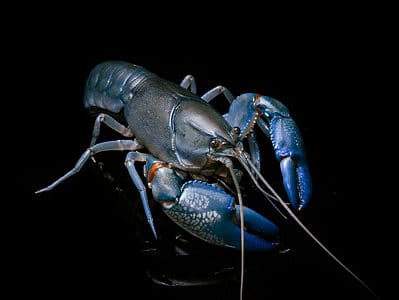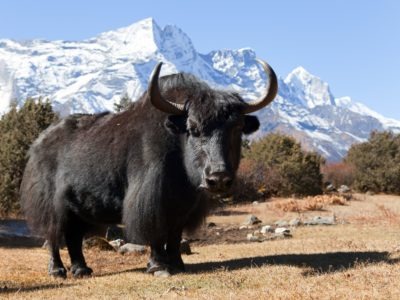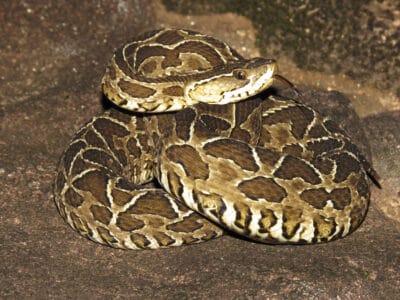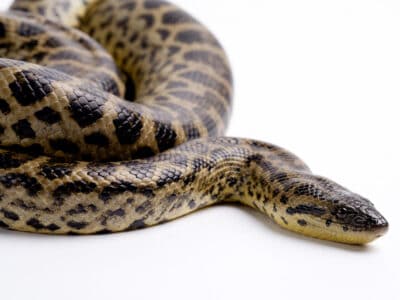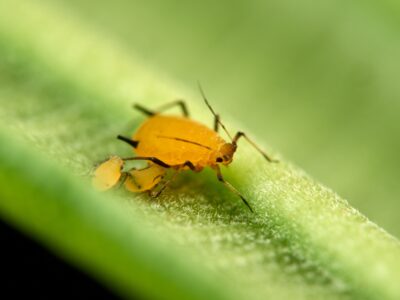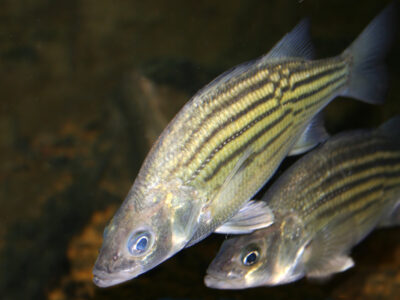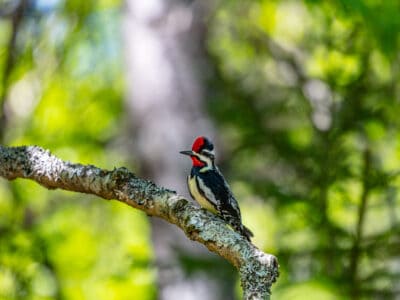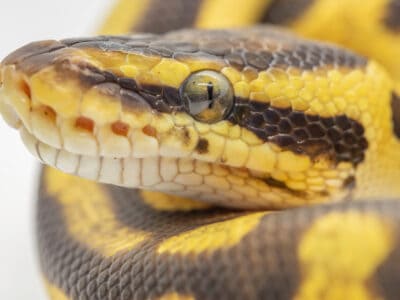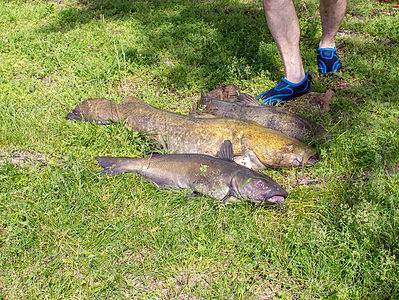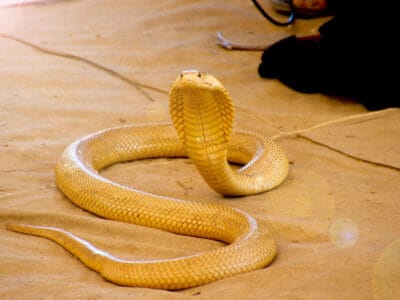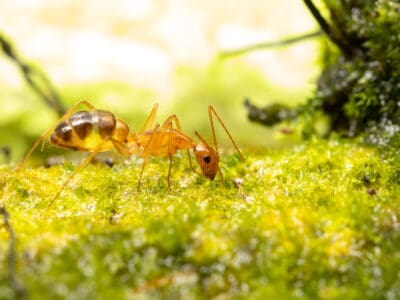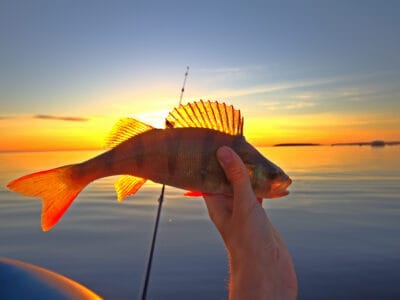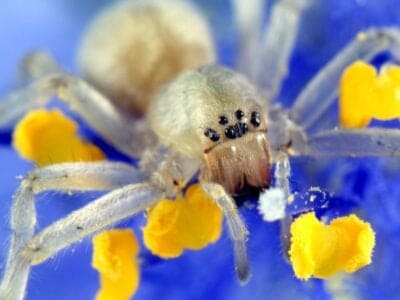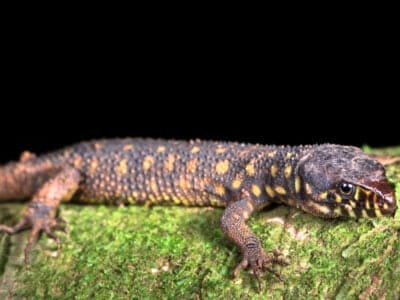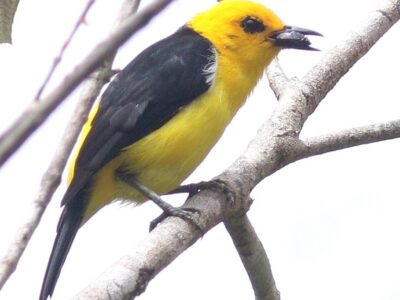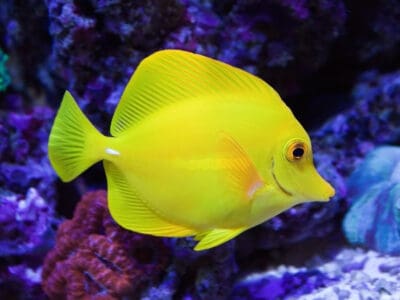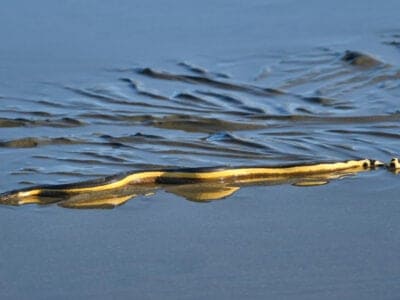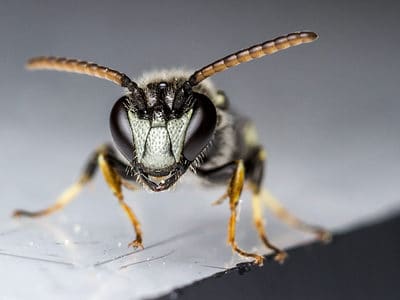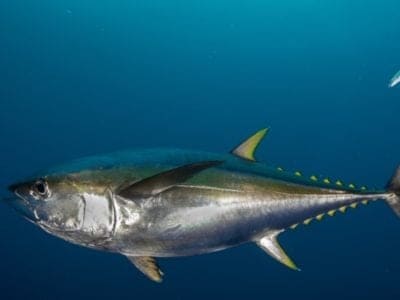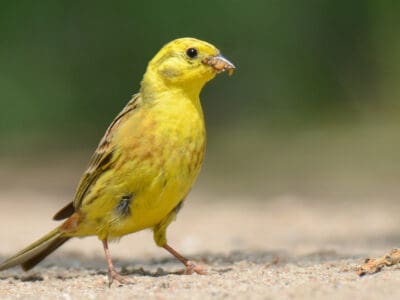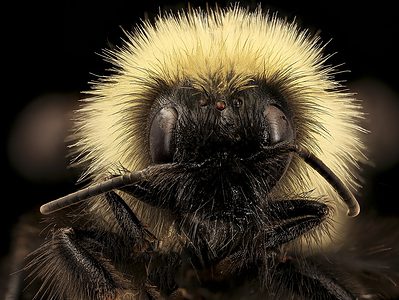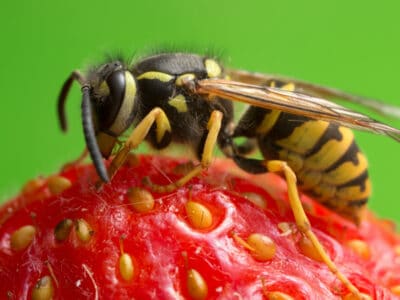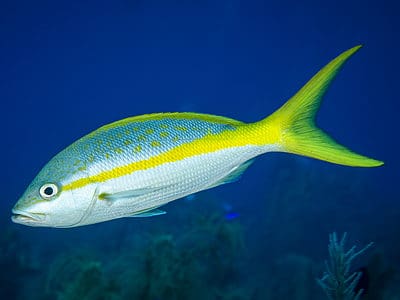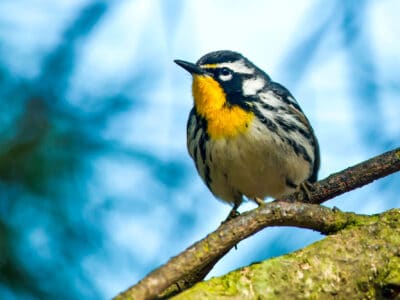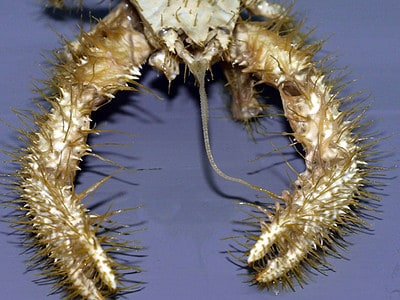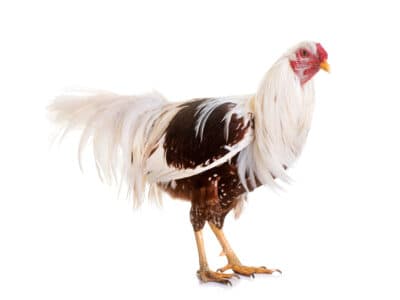Animals that start with the letter Y include Yak, Yellow Bass, Yellow Crazy Ant, Yellow Perch, Yellow Sac Spider, Yellow Tanager, Yellowfin Tuna, Yellowhammer, Yellowjacket, Yellowthroat, Yokohama Chicken, and Yorkshire Terrier.
In total, A-Z Animals currently tracks 32 animals that start with the letter Y. On the page below, you can discover more amazing information and pictures of these incredible animals.
Jump to any letter
Alphabetical List of Animals That Start with Y
- Yabby
- Yak
- Yakutian Laika
- Yarara
- Yellow Anaconda
- Yellow Aphids
- Yellow Bass
- Yellow Bellied Sapsucker
- Yellow Belly Ball Python
- Yellow Bullhead Catfish
- Yellow Cobra
- Yellow Crazy Ant
- Yellow Perch
- Yellow Sac Spider
- Yellow Spotted Lizard
- Yellow Tanager (Black-and-Yellow Tanager)
- Yellow Tang
- Yellow-Bellied Sea Snake
- Yellow-Eyed Penguin
- Yellow-faced Bee
- Yellowfin Tuna
- Yellowhammer
- Yellowish Cuckoo Bumblebee (formerly Fernald’s Cuckoo Bumblebee)
- Yellowjacket (Yellow Jacket)
- Yellowtail Snapper
- Yellowthroat
- Yeti Crab
- Yokohama Chicken
- Yoranian
- Yorkie Bichon
- Yorkiepoo
- Yorkshire Terrier
Animals that Start with Y
Yabby
- Kingdom
- Animalia
- Phylum
- Arthropoda
- Class
- Malacostraca
- Order
- Decapoda
- Family
- Parasticidae
- Genus
- Cherax
- Scientific Name
- Cherax destructor
Fun Fact: The yabby can survive long periods of droughts by burrowing into the soil.
The yabby is a fully-aquatic freshwater crayfish native to Australia and has the widest range of any crayfish on the continent. A member of the Cherax genus, yabby typically live in slow-moving waterways across Australia and New Guinea. It has a unique survival mechanism that allows it to endure long periods of drought. Some members […] Read More
Yak
- Kingdom
- Animalia
- Phylum
- Chordata
- Class
- Mammalia
- Order
- Artiodactyla
- Family
- Bovidae
- Genus
- Bos
- Scientific Name
- Bos grunniens
Fun Fact: Yaks can live at altitudes up to 20,000 feet--the highest of any land-dwelling mammal.
Yaks are heavily built animals with a sturdy frame that have long, thick hair. Yaks are animals that are native to Tibet and China but are also found in Mongolia, Nepal, and Central Asia. Scientists believe that Qiang tribespeople domesticated yak animals at least 5,000 years ago, a claim supported by genetic evidence. However, some […] Read More
Yakutian Laika
- Kingdom
- Animalia
- Phylum
- Chordata
- Class
- Mammalia
- Order
- Carnivora
- Family
- Canidae
- Genus
- Canis
- Scientific Name
- Canis lupus
Fun Fact: The Yakute people were likely the first to use dogs to pull sleds, so the Yakutian Laika was probably among the first sled dogs.
The Yakute people were likely the first to use dogs to pull sleds, so the Yakutian Laika was probably among the first sled dogs. While Yakutian Laikas only recently become more well-known in other parts of the world, they are an ancient breed. As you may be able to guess based on their name, they […] Read More
Yarara
- Kingdom
- Animalia
- Phylum
- Chordata
- Class
- Reptilia
- Order
- Squamata
- Family
- Viperidae
- Genus
- Bothrops
- Scientific Name
- Bothrops alternatus
Fun Fact: Females are much larger than males
Beautiful but dangerous pitviper. This robust-bodied pit viper belongs to one of the most dangerous of the snake genera. Its venom quickly and efficiently kills its prey, and even a small amount can do terrible damage to the human body. Yet this admittedly dangerous and beautifully patterned animal wants no more than to make a […] Read More
Yellow Anaconda
- Kingdom
- Animalia
- Phylum
- Chordata
- Class
- Reptilia
- Order
- Squamata
- Family
- Boidae
- Genus
- Eunectes
- Scientific Name
- E. notaeus
Fun Fact: Anacondas take prey much bigger compared to body weight than other snakes.
Yellow anacondas are generalist carnivores and will eat anything they can overpower with their massive size and strength. These are large snakes in the boa family that live in South America. While not as well-known as the even bigger green anaconda, these snakes achieve lengths of up to 15 feet long and 80 pounds. Amazing […] Read More
Yellow Aphids
- Kingdom
- Animalia
- Phylum
- Arthropoda
- Class
- Insecta
- Order
- Hemiptera
- Family
- Aphididae
- Genus
- Aphis
- Scientific Name
- Aphis nerii
Fun Fact: These aphids are primarily wingless; however, once the infestation on their host gets too crowded, they develop wings, allowing them to fly to a new host plant.
Yellow aphids are parasitic insects that live on host plants like the oleander or milkweed. They are tiny and only measure between 0.059 to 0.10 inches long. As their name depicts, they are yellow in color with pitch black legs. They are generally wingless but may develop wings if the infestation becomes too large so […] Read More
Yellow Bass
- Kingdom
- Animalia
- Phylum
- Chordata
- Class
- Actinopterygii
- Order
- Perciformes
- Family
- Moronidae
- Genus
- Morone
- Scientific Name
- Morone mississippiensis
Fun Fact: Largest yellow bass ever recorded weighed 2.95 pounds
Summary Morone mississippiensis, or the yellow bass, belongs to the temperate bass family Moronidae. This small, aggressive fish originally hails from the Mississippi River and several of its nearby tributaries. Yellow bass congregate in large schools, which means determined anglers can easily catch many in a single fishing session. That said, most anglers tend not […] Read More
Yellow Bellied Sapsucker
- Kingdom
- Animalia
- Phylum
- Chordata
- Class
- Aves
- Order
- Piciformes
- Family
- Picidae
- Genus
- Sphyrapicus
- Scientific Name
- Sphyrapicus varius
Fun Fact: The males are responsible for choosing the nesting tree most of the time. Luckily, cavity nests are often reused for multiple breeding seasons (up to 7 years.)
The yellow-bellied sapsucker is a woodpecker species native to eastern Alaska, Canada, and the northeastern United States. They take their job seriously and will drill a network of little holes into the bark of trees, which are referred to as “sap wells.” Then, they drink the sugary sap that wells up from the tree’s vasculature. […] Read More
Yellow Belly Ball Python
- Kingdom
- Animalia
- Phylum
- Chordata
- Class
- Reptilia
- Order
- Squamata
- Family
- Pythonidae
- Genus
- Python
- Scientific Name
- Python regius
Fun Fact: The yellow belly gene is co-dominant and doesn't completely override other genes.
“Yellow belly ball pythons started as an ‘odd-looking’ normal ball python that Amir Soleymani purchased at a reptile show in 1997.“ Yellow Belly Ball Python Summary Over three million ball pythons have been exported from Africa since the 1970s. Many more are bred in captivity every year, making them one of the most popular pet […] Read More
Yellow Bullhead Catfish
- Kingdom
- Animalia
- Phylum
- Chordata
- Class
- Actinopterygii
- Order
- Siluriformes
- Family
- Ictaluridae
- Genus
- Ameiurus
- Scientific Name
- Ameiurus Natalis
Fun Fact: Bottom dwelling scavenger fish
Native to North America, yellow bullhead catfish have a super keen sense of smell, which they use to find food and navigate their surroundings. Yellow Bullhead Catfish Summary These catfish can be found in streams, rivers, and lakes throughout the United States. They are considered to be a hardy species with a substantial population and […] Read More
Yellow Cobra
- Kingdom
- Animalia
- Phylum
- Chordata
- Class
- Reptilia
- Order
- Squamata
- Family
- Elapidae
- Genus
- Naja
- Scientific Name
- Naja nivea
Fun Fact: The Yellow Cobra belong to one of the most dangerous families in the world.
The Yellow Cobra, or Cape cobra is a highly venomous creature located in southern Africa. Among other names, there’s the brown cobra and koperkapel. That loosely translates, in the Afrikaans language, to copper cobra. You’ll run into the snake throughout the Northern, Western, and Eastern Cape, North West Province, Free State, and many other parts […] Read More
Yellow Crazy Ant
- Kingdom
- Animalia
- Phylum
- Arthropoda
- Class
- Insecta
- Order
- Hymenoptera
- Family
- Formicidae
- Genus
- Anoplolepis
- Scientific Name
- Anoplolepis gracilipes
Fun Fact: One of the top 100 worst invasive species!
The yellow crazy ant is so called because of its color, as well as the frenetic movements it makes when disturbed. Unlike other ant species, these pests don’t bite or sting – they spray acid! Yellow crazy ants may be tiny, but they have decimated ecosystems and are behind millions of dollars’ worth of damage. […] Read More
Yellow Perch
- Kingdom
- Animalia
- Phylum
- Chordata
- Class
- Actinopterygii
- Order
- Perciformes
- Family
- Percidae
- Genus
- Perca flavescens
- Scientific Name
- Perca flavescens
Fun Fact: Female Yellow Perch grom larger than the males.
The Yellow Perch is an abundant freshwater fish in the northern areas of North America. It is recognized by its gold or yellow body with dark vertical stripes. It is a popular sport and commercial fish, especially in the Great Lakes region. The Yellow Perch has many common names, such as Striped Perch, American Perch, Coontail, Lake […] Read More
Yellow Sac Spider
- Kingdom
- Animalia
- Phylum
- Arthropoda
- Class
- Arachnida
- Order
- Araneae
- Family
- Cheiracanthiidae
- Genus
- Cheiracanthium
Fun Fact: Primarily Carnivorous, but sometimes snacks on nectar.
A Yellow Sac Spider is a beneficial species native to the United States where it is found primarily in the northeastern to midwestern states. Similar species to the American version are found in many countries around the world including Germany and Australia. These spiders are active hunters who do not wait in a web for […] Read More
Yellow Spotted Lizard
- Kingdom
- Animalia
- Phylum
- Chordata
- Class
- Reptilia
- Order
- Squamata
- Family
- Xantusiidae
- Genus
- Lepidophyma
- Scientific Name
- Lepidophyma flavimaculatum
Fun Fact: Gives birth to live young.
The yellow-spotted lizard has seemingly gained popularity through the book Holes, but there’s a lot of misinformation about them as a result. These nocturnal lizards prefer a warm and humid environment, primarily remaining in the same region for their entire life. They primarily eat insects, and they give birth to live young. With a lifespan […] Read More
Yellow Tanager (Black-and-Yellow Tanager)
- Kingdom
- Animalia
- Phylum
- Chordata
- Class
- Aves
- Order
- Thraupidae
- Family
- Thraupidae
- Genus
- Chrysothylpis
- Scientific Name
- Chrysothylpis chrysomelas
Fun Fact: They swallow soft fruit whole
“They feed on small fruit, which they swallow whole.” Summary The yellow tanager (black-and-yellow tanager) is a small passerine bird endemic to South America. It inhabits forest canopies, edges, and clearings near the Caribbean in the foothills of central mountains. While this species is relatively common in its habitat, there is much we still don’t […] Read More
Yellow Tang
- Kingdom
- Animalia
- Phylum
- Chordata
- Class
- Actinopterygii
- Family
- Acanthuridae
- Genus
- Zebrasoma
- Scientific Name
- Zebrasoma flavescens
Fun Fact:
You may be familiar with the popular Blue Tang thanks to the beloved Dory character in Finding Nemo, but did you know that Dori has a yellow relative? The Yellow Tang, known by its scientific name Zebrasoma flavescens, is a bright yellow color with the signature shape of a tang. It lives in reefs and […] Read More
Yellow-Bellied Sea Snake
- Kingdom
- Animalia
- Phylum
- Chordata
- Class
- Reptilia
- Order
- Squamata
- Family
- Elapidae
- Genus
- Hydrophis
- Scientific Name
- Hydrophis platurus
Fun Fact: Sea snakes spend approximately 90% of their lives under water.
The yellow-bellied sea snake has the largest habitat range of any snake species in the world. The yellow-bellied sea snake belongs to a unique genus that inhabits marine environments. It stays in the water during its entire life and cannot even properly move or stay upright on land. The species has many unique adaptations to […] Read More
Yellow-Eyed Penguin
- Kingdom
- Animalia
- Phylum
- Chordata
- Class
- Aves
- Order
- Sphenisciformes
- Family
- Spheniscidae
- Genus
- Megadyptes
- Scientific Name
- Megadyptes antipodes
Fun Fact: The rarest species of penguin!
“Yellow-eyed penguins are uniquely characterized by their pale yellow eyes” The only penguins belonging to the genus Megadyptes, the yellow-eyed penguins are uniquely characterized by their pale yellow eyes. Usually found in Stewart, Auckland, and Campbell Islands, these penguins can also be distinguished by yellow eyeballs and yellow feathers that rest at the peak of […] Read More
Yellow-faced Bee
- Kingdom
- Animalia
- Phylum
- Arthropoda
- Class
- Insecta
- Order
- Hymenoptera
- Family
- Colletidae
- Genus
- Hylaeus
Fun Fact: N/A
Yellow-faced bees are small insects in the genus Hyleaus. Yellow-faced bees are found on every continent except Antarctica. They belong to the family Colletidae, which contains over 2000 species of bees! Hylaeus contains over 500 species, and North America is home to 130 species of them. They are distinctive for the yellow, white, or black […] Read More
Yellowfin Tuna
- Kingdom
- Animalia
- Phylum
- Chordata
- Class
- Actinopterygii
- Order
- Scombriformes
- Family
- Scombridae
- Genus
- Thunnus
- Scientific Name
- Thunnus albacares
Fun Fact: The yellowfin forms schools with other tuna species
The yellowfin is the second most commonly eaten tuna species in the world. With its yellow coloring and huge secondary fins, this species is unmistakable and easy to recognize. 3 Incredible Yellowfin Tuna Facts! As it migrates around the globe, the yellowfin tuna fish forms large schools with skipjack, bigeye, and even dolphins and whales.This […] Read More
Yellowhammer
- Kingdom
- Animalia
- Phylum
- Chordata
- Class
- Aves
- Order
- Passeriformes
- Family
- Emberizidae
- Genus
- Emberiza
- Scientific Name
- Emberiza citrinella
Fun Fact: It interbreeds with the pine bunting
“Males learn songs from their fathers and develop regional dialects.” Summary The yellowhammer (Emberiza citrinella) is a large bunting native to Eurasia. It inhabits dry, open country areas with clusters of trees and wide-ranging vegetation. This species is rather social, forming monogamous pair bonds during breeding and foraging in large, mixed-species flocks. They sing their […] Read More
Yellowish Cuckoo Bumblebee (formerly Fernald’s Cuckoo Bumblebee)
- Kingdom
- Animalia
- Phylum
- Arthropoda
- Class
- Insecta
- Order
- Hymenoptera
- Family
- Apidae
- Genus
- Bombus
- Scientific Name
- Bombus flavidus
Fun Fact: N/A
The yellowish cuckoo bumblebee (Bombus flavidus), was until quite recently called by an entirely different name in North America. Bombus fernaldae, commonly called Fernald’s cuckoo bumblebee, was formerly thought to be its own distinct species. However, as of the spring of 2021, Fernald’s is no more. When it was determined that Bombus fernaldae and Bombus […] Read More
Yellowjacket (Yellow Jacket)
- Kingdom
- Animalia
- Phylum
- Arthropoda
- Class
- Insecta
- Order
- Hymenoptera
- Family
- Vespidae
- Genus
- Vespula or Dolichovespula
Fun Fact: Yellowjacket stings account for the majority of deaths from wasp stings
Yellowjacket stings account for the majority of deaths from wasp stings Summary The hardy wasps, occasionally mistaken for bees and hornets, have many fascinating traits. Yellowjackets are characterized by their vivid black and yellow stripes. They are scavengers and carnivores known to feed on other insects and arachnids. With venom stings potent enough to kill […] Read More
Yellowtail Snapper
- Kingdom
- Animalia
- Phylum
- Chordata
- Class
- Actinopterygii
- Order
- Perciformes
- Family
- Lutjanidae
- Genus
- Ocyurus
- Scientific Name
- Ocyurus chrysurus
Fun Fact: Fast moving ocean fish with a long yellow stripe.
The yellowtail snapper is a beautiful fish with a striking yellow tail that is one of the most sought-after fish for human consumption. Yellowtail Snapper Summary As you can tell from its name, this fish is a member of the snapper family. It is a fish with a unique bright yellow tail native to the […] Read More
Yellowthroat
- Kingdom
- Animalia
- Phylum
- Chordata
- Class
- Aves
- Order
- Passeriformes
- Family
- Parulidae
- Genus
- Geothlypis
- Scientific Name
- Geothlypis trichas, Geothlypis beldingi, and others
Fun Fact: They forage near the ground, searching leaves for insects
“Yellowthroats are curious birds attracted to repetitive noises.” Summary The yellowthroat is a common songbird from the wood-warbler family. They have an extensive range across two continents and over 40 countries. These birds inhabit marshes and wetlands in open spaces, where they stay low to the ground to avoid predators and to search for food. […] Read More
Yeti Crab
- Kingdom
- Animalia
- Phylum
- Arthropoda
- Class
- Malacostraca
- Order
- Decapoda
- Family
- Kiwaidae
- Genus
- Kiwa
Fun Fact: The yeti crab has hairy arms, which collect bacteria to feed on
The yeti crab is a family of deep-sea decapods crustaceans (essentially, lobsters and crabs) with hairy arms and a white shell. The very first species (Kiwa hirsuta) was only discovered in 2005 on a hydrothermal vent near Easter Island. Despite its reduced eyes and blindsight, the yeti crab nevertheless has several unique adaptations to survive […] Read More
Yokohama Chicken
- Kingdom
- Animalia
- Phylum
- Chordata
- Class
- Aves
- Order
- Galliformes
- Family
- Phasianidae
- Genus
- Gallus
- Scientific Name
- Gallus gallus
Fun Fact: Yokohama chickens have snow white feathers with tails reaching up to 4 feet in length.
The ornamental Yokohama chicken was originally bred from Japanese long-tailed chickens that were exported from the Yokohama port in Japan in 1864. These exported chickens were known as Minohiki chickens in their native Japan. They were renamed for their port of departure and brought to Germany. The Japanese long-tailed Minohiki were thought to be descended […] Read More
Yoranian
- Kingdom
- Animalia
- Phylum
- Chordata
- Class
- Mammalia
- Order
- Carnivora
- Family
- Canidae
- Genus
- Canis
- Scientific Name
- Canis lupus familiaris
Fun Fact: These dogs are very intelligent and are great with children.
The Yoranian is incredibly intelligent. Introduction Yoranians are hybrid dogs, a crossbreed between a Yorkshire Terrier and a Pomeranian. They are often referred to as a Yorkie Pom or Porkie Pom. They are tiny in size, growing are only six to ten inches in height. Their weight varies from three to seven pounds. They are […] Read More
Yorkie Bichon
- Kingdom
- Animalia
- Phylum
- Chordata
- Class
- Mammalia
- Order
- Carnivora
- Family
- Canidae
- Genus
- Canis
- Scientific Name
- Canis lupus
Fun Fact: Yorkie Bichons can come in a wide range of colors including black, white, blonde, gray, golden, or dark brown.
Yorkie Bichons can come in a wide range of colors including black, white, blonde, gray, golden, or dark brown. Yorkie Bichons are a hybrid breed created by mixing a Bichon Frise with a Yorkshire Terrier. Also called Yorkshire Frises, Bichyorkies, Yorkie Chons, and Bichon Yorkies, these dogs are playful and intelligent. They can be independent, […] Read More
Yorkiepoo
- Kingdom
- Animalia
- Phylum
- Chordata
- Class
- Mammalia
- Order
- Carnivora
- Family
- Canidae
- Genus
- Canis
- Scientific Name
- Canis lupus
Fun Fact: The Yorkie-Poo originated from the hybrid poodle phase of the late 20th century
Did you know that a full grown Yorkiepoo is among the smallest types of dogs in the world? Some are so small that they can fit inside of a teacup; hence, the smallest members of this mix are called “teacup” dogs! The Yorkiepoo is a unique mix between a purebred Yorkshire terrier and a toy […] Read More
Yorkshire Terrier
- Kingdom
- Animalia
- Phylum
- Chordata
- Class
- Mammalia
- Order
- Carnivora
- Family
- Canidae
- Genus
- Canis
- Scientific Name
- Canis lupus
Fun Fact: Highly energetic and eager for adventure!
The Yorkshire Terrier, a.k.a. the Yorkie, is the epitome of the toy-size canine. It’s a dainty thing, typically growing to no more than seven pounds and no more than nine inches at the shoulder. Though the teacup pup’s considered a purebred, his origin is from cross-breeding. He’s a mix from breeders crossing the Clydesdale terrier […] Read More

Animal by Letter Lists
- Animals that Start with A
- Animals that Start with B
- Animals that Start with C
- Animals that Start with D
- Animals that Start with E
- Animals that Start with F
- Animals that Start with G
- Animals that Start with H
- Animals that Start with I
- Animals that Start with J
- Animals that Start with K
- Animals that Start with L
- Animals that Start with M
- Animals that Start with N
- Animals that Start with O
- Animals that Start with P
- Animals that Start with Q
- Animals that Start with R
- Animals that Start with S
- Animals that Start with T
- Animals that Start with U
- Animals that Start with V
- Animals that Start with W
- Animals that Start with X
- Animals that Start with Y
- Animals that Start with Z
Thank you for reading! Have some feedback for us? Contact the AZ Animals editorial team.




